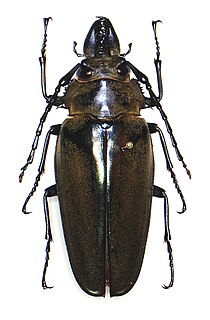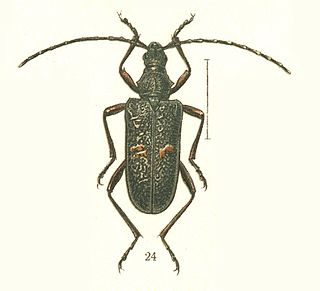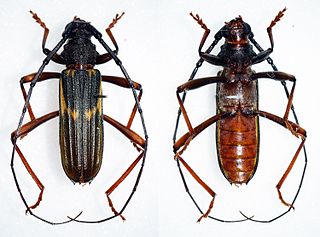
The longhorn beetles (Cerambycidae), also known as long-horned or longicorns, are a large family of beetles, with over 35,000 species described. Most species are characterized by extremely long antennae, which are often as long as or longer than the beetle's body. In various members of the family, however, the antennae are quite short and such species can be difficult to distinguish from related beetle families such as the Chrysomelidae. The scientific name of this beetle family goes back to a figure from Greek mythology: after an argument with nymphs, the shepherd Cerambus was transformed into a large beetle with horns.
Francis Polkinghorne Pascoe was an English entomologist mainly interested in beetles.

Lamiinae, commonly called flat-faced longhorns, are a subfamily of the longhorn beetle family (Cerambycidae). The subfamily includes over 750 genera, rivaled in diversity within the family only by the subfamily Cerambycinae.

The Disteniidae are a small family of beetles in the superfamily Chrysomeloidea, traditionally treated as a group within the Cerambycidae.

Knulliana is a genus of longhorn beetles. It is monotypic, being represented by the single species Knulliana cincta, commonly known as the banded hickory borer. The species may be found throughout the eastern half of North America, including Mexico and the Bahamas, with one subspecies extending to the Sonoran Desert.

Lepturinae, the lepturine beetles, is a subfamily of the longhorn beetle family (Cerambycidae), containing about 150 genera worldwide. This lineage is most diverse in the Northern Hemisphere. Until recently the subfamily Necydalinae was included within the lepturines, but this has been recently recognized as a separate subfamily. Nine tribes are usually recognized today, with a tenth, Caraphiini, created in 2016. A few genera are of uncertain placement within the subfamily.

The Trictenotomidae are a small family of beetles in the superfamily Tenebrionoidea, containing fifteen species in two genera. Most species are found in the Oriental realm where they live in montane forest habitats. The family is considered, based on larval characters as well as sequence-based studies, to be closely related to the Salpingidae.

Sachalinobia is a genus of flower longhorns in the beetle family Cerambycidae. There are at least two described species in Sachalinobia.

Bothriospilini is a tribe of beetles in the subfamily Cerambycinae. The tribe was proposed in 1950 by Brazilian entomologist Frederico Lane as a member of the new subfamily Bothriospilinae, and with Bothriospila assigned as the type genus. The tribe is morphologically close to the tribe Torneutini, with which it has in common the same shape of the last abdominal segment, which is wide and largely braided in the female, as well as the anterior thigh cavities that are open from behind and the laterally open medial cavity.

Bothriospila is a genus of beetles in the family Cerambycidae, and the type genus of the tribe Bothriospilini. It contains two species: the type, Bothriospila elegans, found in Brazil and Paraguay, and Bothriospila pulcherrima, found in Brazil. The latter was described as a new species from Brazil in 2012. Bothriospila was circumscribed in 1923 by Swedish entomologist Per Olof Christopher Aurivillius.

Ochraethes is a genus of beetles in the family Cerambycidae.

Trachyderini is a tribe of long-horned beetles in the family Cerambycidae. There are at least 140 genera and 650 described species in Trachyderini.
Adalbus crassicornis is a species of longhorn beetle in the Cerambycinae subfamily, and the only species in the genus Adalbus. It was described by Fairmaire and Germain in 1859. It is known from Chile and western Argentina. Its host plants are Nothofagus pumilio, Nothofagus dombeyi, Nothofagus antarctica, and Nothofagus alpina. Specimens have been collected in regions where the Chilean pine grows, including Cordillera de Nahuelbuta, Cherquenco, and Caramávida.
Chlorida fasciata is a species of beetle in the family Cerambycidae. It was described by Henry Walter Bates in 1870. It is known to occur in Brazil and Peru.
Mionochroma elegans is a species of beetle in the family Cerambycidae. It was described by Olivier in 1790. It is known from Guadeloupe, Grenada, Dominica, and St. Lucia.
Xylotrechus integer is a species of beetle in the family Cerambycidae. It was described by Haldeman in 1847. This species is known for being located in the Maritime provinces, Quebec, and are very common and widespread throughout Ontario, Canada.
Dmytro Zajciw was a Ukrainian and Brazilian entomologist, notable for his collection and for his many beetle discoveries. He was born in Velyka Mykhailivka, Ukraine and died in Rio de Janeiro, Brazil. He was the author of Two new genera and species of neotropical Longhorn beetles , 1957, Contribution to the study of Longhorn beetles of Rio de Janeiro , 1958, and was the first to describe the genera Adesmoides and Pseudogrammopsis, as well as the species Beraba angusticollis and Mionochroma subaurosum, among many others.
Eupogonius subaeneus is a species of beetle in the family Cerambycidae. It was described by Bates in 1872. It is known from Nicaragua, French Guiana and Colombia.

Charles Frederic August Schaeffer was an American entomologist who specialized in beetles, particularly chrysomelids and weevils. He described 109 species in 91 genera and some species like Taphrocerus schaefferiNicolay & Weiss were described from his collections and named after him.
Atelodesmis mannerheimii is a species of beetle in the family Cerambycidae. It was described by Duponchel & Chevrolat in 1841. It is known from Brazil.











